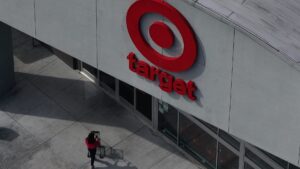Target’s Strategic Revamp: Aiming for $15 Billion in Revenue Growth
In a bold move that has captured the attention of investors and retail enthusiasts alike, Target is laying out a comprehensive strategy aimed at rejuvenating its brand and significantly increasing revenue. Announced during a recent investor meeting in New York City, the retail giant is set to double down on its third-party marketplace, media network, and same-day delivery services with an ambitious goal of generating over $15 billion in revenue growth in the next five years.
Navigating a Rough Patch
Target finds itself at a critical juncture, facing challenges in growing sales, particularly in high-margin discretionary merchandise. As the retailer weighs its options against stiff competition from heavyweights like Amazon and Walmart, it’s clear that a strategic overhaul is necessary to reclaim its competitive edge.
On Tuesday, shares of Target dipped more than 5% following the release of its fiscal 2024 fourth-quarter earnings report, which forecast a “meaningful” profit drop due to weak sales in February. The stock has plummeted nearly 11% since the beginning of the year, underlining the urgency for change.
The Path Forward: A Comprehensive Growth Strategy
During the investor presentation, Target’s CEO Brian Cornell emphasized a multi-faceted growth strategy designed to restore what fans fondly refer to as “Tarzhay magic.” The company’s plan includes enhancing the in-store shopping experience, introducing fresh and innovative products, and investing in a more efficient supply chain.
One of the standout components of the strategy involves expanding Target’s third-party marketplace, reflecting a similar approach taken by Walmart to improve its digital footprint. Target’s initiative aims to boost third-party digital sales from approximately $1 billion in 2024 to over $5 billion by 2030. However, the company is taking a more curated approach by focusing on major brand partnerships rather than opening the floodgates to countless small resellers.
According to Chief Commercial Officer Rick Gomez, “Rather than opening the doors to any seller, we’re focused on building relevance and trust by working with partners that complement our assortment.” Notable brands such as Peloton and Honest Baby Clothing are among those being invited to enrich Target’s offerings.
Transforming Media and Marketing
Beyond its marketplace ambitions, Target is also strategizing to double the size of its in-house media company, Roundel, by 2030. This unit has already generated significant revenue, producing over $2 billion last year. By enhancing its advertising capabilities, Target hopes to capitalize on the growing importance of targeted marketing, similar to Walmart’s successful efforts with Walmart Connect.
Reinforcing Retail Fundamentals
While innovation is key, Target recognizes the importance of solidifying its retail foundation. COO Michael Fiddelke reiterated that “retail is about product,” emphasizing a commitment to revamping product assortments and improving inventory management. The company aims to tackle inventory shortages, which have significantly impacted sales, particularly in high-margin categories like apparel and home goods.
To achieve this, Target plans to invest between $4 billion and $5 billion in improving its stores and supply chain. This includes modernizing its inventory management systems through AI-driven technologies, further enhancing the shopping experience for customers both online and in-store.
Expanding Assortments and Collaborations
Another aspect of Target’s strategy is the expansion of its product offerings. The company aims to bolster its selections in gaming, sports, and toys while enhancing its home goods range, which has traditionally been a strong revenue driver. Target is also poised to roll out approximately 600 new food and beverage items under its Good & Gather and Favorite Day private label brands, as well as revamping its pet supplies offerings.
Further reinforcing its brand identity, Target will collaborate with celebrity chefs like Ann Kim on new product lines, signaling a creative and trendy approach to product development.
Looking Ahead
With plans to open 20 new stores, primarily larger formats, and remodel existing locations, Target is poised to re-establish itself as a retail leader. The company’s emphasis on fresh, compelling products—designed to captivate shoppers and spark impulse purchases—remains central to its long-term vision.
At Extreme Investor Network, we believe Target’s revitalization strategy represents a significant opportunity for investors to consider. As the brand navigates these challenging waters, its focus on innovation, strategic partnerships, and customer experience positions it well for future growth. Stay tuned for updates as Target embarks on this ambitious journey.

